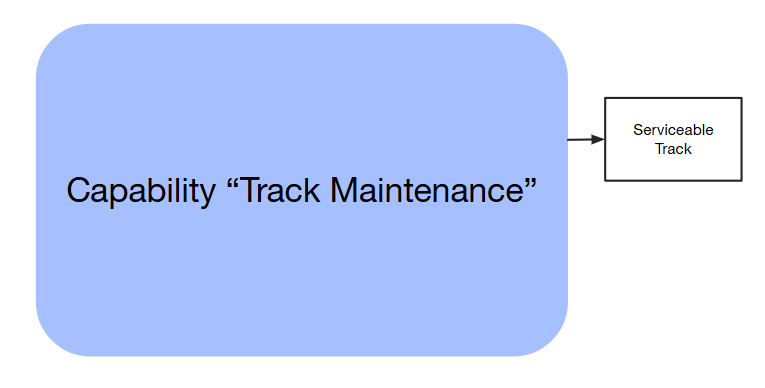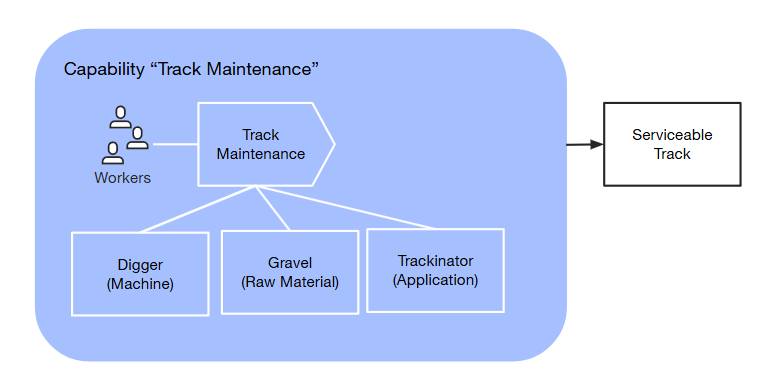No edit summary |
No edit summary |
||
| (4 intermediate revisions by the same user not shown) | |||
| Line 1: | Line 1: | ||
<small>[[Capability Modeling Guidelines]] | [[Capability_Modeling_Guidelines:_How_to_Structure_a_Capability_Map|How to Structure a Capability Map]]</small> | <small>[[Capability Modeling Guidelines|Capability Modelling Guidelines]] | [[Capability_Modeling_Guidelines:_How_to_Structure_a_Capability_Map|How to Structure a Capability Map]]</small> | ||
=Design capabilities as | =Design capabilities as organic modules= | ||
At the start of your [[capability]] | At the start of your [[capability]] modelling initiative, [[capability|capabilities]] are designed as the intended [[outcome|outcomes]] needed for [[product]] creation. Initially, these [[outcome|outcomes]] are designed as black boxes that accept inputs and an (as yet) unknown configuration of [[people]], [[process|processes]], and [[asset|assets]] transforms those inputs into well-defined, distinctive outputs needed to create [[product|products]]. In this way, you start designing the boundaries of [[capability|capabilities]] that can later be brought to life by [[people]] who build and continually refine the required [[organisation]], [[process|processes]] and [[asset|assets]]. | ||
[[File:CMG_Organic_Modules_1.png|800px]]<br> | [[File:CMG_Organic_Modules_1.png|800px]]<br> | ||
<small>''Defining the boundary of an organic module: Intersection Railways aims for the outcome to perform | <small>''Defining the boundary of an organic module: Intersection Railways aims for the outcome to perform 'Track Maintenance' ''</small> | ||
<br><br> | <br><br> | ||
All of an [[enterprise|enterprise’s]] [[capability|capabilities]] together form the scaffold of its [[architecture]]. Similar to garden beds being the basic structural elements of a garden, [[capability|capabilities]] can be seen as the organic modules of a composable [[enterprise]] where [[capabilities]] are cultivated, living systems that emerge within designed boundaries. Think of a [[capability]] as a plant bed, an | All of an [[enterprise|enterprise’s]] [[capability|capabilities]] together form the scaffold of its [[architecture]]. Similar to garden beds being the basic structural elements of a garden, [[capability|capabilities]] can be seen as the organic modules of a composable [[enterprise]] where [[capabilities]] are cultivated, living systems that emerge within designed boundaries. Think of a [[capability]] as a plant bed, an 'organic business module' where the collaborative top-down design defines the boundaries of the beds, while the many [[people]] accountable for creating and improving the [[capability]] plant the seeds and shape its detailed design. | ||
Once realised, a [[capability]] functions as a module that is as independent as possible in realising the output, containing all the means to realise the output. It is the continuously and organically emerging [[outcome]] of orchestrating [[people]] with the right skills, [[process|processes]] and [[asset|assets]] to create the outputs that support the [[enterprise|enterprise’s]] [[purpose|purposes]] and/or the [[task|tasks]] of [[people]]. | Once realised, a [[capability]] functions as a module that is as independent as possible in realising the output, containing all the means to realise the output. It is the continuously and organically emerging [[outcome]] of orchestrating [[people]] with the right skills, [[process|processes]] and [[asset|assets]] to create the outputs that support the [[enterprise|enterprise’s]] [[purpose|purposes]] and/or the [[task|tasks]] of [[people]]. | ||
[[File:CMG_Organic_Modules_2.png|800px]]<br> | [[File:CMG_Organic_Modules_2.png|800px]]<br> | ||
<small>''People, Process and Assets needed to perform | <small>''People, Process and Assets needed to perform 'Track Maintenance' ''</small> | ||
==Practical | ==Practical tips== | ||
'''Well-defined, distinctive outputs.''' | '''Well-defined, distinctive outputs.''' | ||
| Line 23: | Line 23: | ||
'''Keep together what belongs together.''' | '''Keep together what belongs together.''' | ||
[[Capability_Modeling_Guidelines:_Designing_around_Activities_or_Objects|Group activities]] that require similar skills, [[processes]] or [[assets]] into a single higher-level [[capability]] ( | [[Capability_Modeling_Guidelines:_Designing_around_Activities_or_Objects|Group activities]] that require similar skills, [[processes]] or [[assets]] into a single higher-level [[capability]] ('tight coupling'). | ||
Strive for | Strive for 'loose coupling' between [[capabilities]]: many interactions (between [[people]], [[processes]], and [[assets]]) within a [[capability]] and few interactions between [[capabilities]]. | ||
'''Focus on critical [[capability]] differences only.''' | '''Focus on critical [[capability]] differences only.''' | ||
When a significant variation is required, consider adding a critical few [[capabilities]] at the appropriate level in the model. | When a significant variation is required, consider adding a critical few [[capabilities]] at the appropriate level in the model. | ||
<br><br> | |||
{| style="width:100%;" | |||
| style="text-align:left; width:50%;" | [[Capability_Modeling_Guidelines:_How_to_Structure_a_Capability_Map|← Previous page]] | |||
| style="text-align:right; width:50%;" | [[Capability_Modeling_Guidelines:_Capability_Categories|Next page →]] | |||
|} | |||
Latest revision as of 13:45, 13 September 2025
Capability Modelling Guidelines | How to Structure a Capability Map
Design capabilities as organic modules
At the start of your capability modelling initiative, capabilities are designed as the intended outcomes needed for product creation. Initially, these outcomes are designed as black boxes that accept inputs and an (as yet) unknown configuration of people, processes, and assets transforms those inputs into well-defined, distinctive outputs needed to create products. In this way, you start designing the boundaries of capabilities that can later be brought to life by people who build and continually refine the required organisation, processes and assets.

Defining the boundary of an organic module: Intersection Railways aims for the outcome to perform 'Track Maintenance'
All of an enterprise’s capabilities together form the scaffold of its architecture. Similar to garden beds being the basic structural elements of a garden, capabilities can be seen as the organic modules of a composable enterprise where capabilities are cultivated, living systems that emerge within designed boundaries. Think of a capability as a plant bed, an 'organic business module' where the collaborative top-down design defines the boundaries of the beds, while the many people accountable for creating and improving the capability plant the seeds and shape its detailed design.
Once realised, a capability functions as a module that is as independent as possible in realising the output, containing all the means to realise the output. It is the continuously and organically emerging outcome of orchestrating people with the right skills, processes and assets to create the outputs that support the enterprise’s purposes and/or the tasks of people.

People, Process and Assets needed to perform 'Track Maintenance'
Practical tips
Well-defined, distinctive outputs.
Design capabilities to deliver well-defined outputs (e.g. a completed station or a serviceable track). Avoid redundancy-no two capabilities should produce the same or very similar output.
Keep together what belongs together.
Group activities that require similar skills, processes or assets into a single higher-level capability ('tight coupling').
Strive for 'loose coupling' between capabilities: many interactions (between people, processes, and assets) within a capability and few interactions between capabilities.
Focus on critical capability differences only.
When a significant variation is required, consider adding a critical few capabilities at the appropriate level in the model.
| ← Previous page | Next page → |